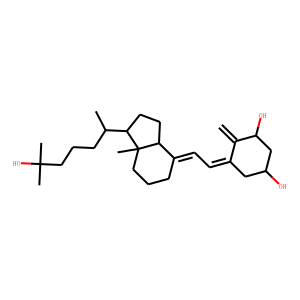| IUPAC Name | (1R,3S,5Z)-5-[(2E)-2-[(1R,3aS,7aR)-1-[(2R)-6-hydroxy-6-methylheptan-2-yl]-7a-methyl-2,3,3a,5,6,7-hexahydro-1H-inden-4-ylidene]ethylidene]-4-methylidenecyclohexane-1,3-diol |
| InChI | InChI=1S/C27H44O3/c1-18(8-6-14-26(3,4)30)23-12-13-24-20(9-7-15-27(23,24)5)10-11-21-16-22(28)17-25(29)19(21)2/h10-11,18,22-25,28-30H,2,6-9,12-17H2,1,3-5H3/b20-10+,21-11-/t18-,22-,23-,24+,25+,27-/m1/s1 |
| Reference | 1. Mol Cancer Ther. 2004 Mar;3(3):373-81.Calcitriol in cancer treatment: from the lab to the clinic.Beer TM(1), Myrthue A.
<div>
</div>
<div>
1,25-Dihydroxyvitamin D (calcitriol), the most active metabolite of vitamin D, has significant antineoplastic activity in preclinical models. Several mechanisms of activity have been proposed. These include inhibition of proliferation associated with cell cycle arrest and, in some models, differentiation, reduction in invasiveness and angiogenesis, and induction of apoptosis. Proposed mechanisms differ between tumor models and experimental conditions, and no unifying hypothesis about the mechanism of antineoplastic activity has emerged. Synergistic and/or additive effects with cytotoxic chemotherapy, radiation, and other cancer drugs have been reported. Significantly supraphysiological concentrations of calcitriol are required for antineoplastic effects. Such concentrations are not achievable in patients when calcitriol is dosed daily due to predictable hypercalcemia and hypercalcuria; however, phase I trials have demonstrated that intermittent dosing allows substantial dose escalation and has produced potentially therapeutic peak calcitriol concentrations. Recently, a phase II study reported encouraging levels of activity for the combination of high-dose calcitriol and docetaxel </div>
<div>
administered on a weekly schedule in patients with androgen-independent prostate cancer. This regimen is now under study in a placebo-controlled randomized trial in androgen-independent prostate cancer and in phase II studies in several other tumor types. Further work is needed to elucidate the molecular mechanisms of antineoplastic activity and optimal clinical applications of calcitriol in cancer.</div>
<div>
</div>
<div>
2. Curr Vasc Pharmacol. 2014 Mar;12(2):294-9. doi: 10.2174/15701611113119990021. Therapeutic use of calcitriol.Rodriguez M, Munoz-Castaneda JR, Almaden Y(1).</div>
<div>
</div>
<div>
The synthesis of 1α,25-dihydroxyvitamin D3 (Calcitriol) takes place mostly in the kidneys through the action of 1α-hydroxylase (CYP27B1) which converts 25(OH)D into 1,25(OH)2D3. Renal production of calcitriol is stimulated by PTH, low calcium and low phosphate and it is reduced by high phosphate and FGF23. Binding of 1α,25-dihydroxyvitamin D3 to its receptor (VDR) causes gut absorption of calcium and phosphate, decrease in PTH synthesis, stimulation of FGF23. At the bone level calcitriol suppresses pre-osteoblasts and activates mature osteoblasts. VDR is present in a large variety of cells that do not have any direct role in the regulation of mineral metabolism. Calcitriol regulates immune and inflammatory response, cell turnover, cell differentiation, Renin production, reduces proteinuria and others. In patients with Chronic Kidney Disease (CKD) there is a decrease in calcitriol that is apparent at early stages of renal disease; this is probably due to the elevation of FGF23 which is present since very early stage of CKD. In CKD stage, 3-4 moderate doses of calcitriol are effective to control secondary hyperparathyroidism and observational studies suggest that calcitriol therapy increases survival and slows the progression of renal disease as long as phosphate and calcium levels are controlled. Calcitriol (0.5 µg calcitriol twice per week) has been effective in decreasing proteinuria in patients with IgA nephropathy. In dialysis patients, the administration of calcitriol reduces serum PTH levels but it is also known that high doses of calcitriol are associated with hypercalcemia and worse control of hyperphosphatemia. In kidney transplant patients, the administration of calcitriol, 0.5 µg/48h prevents bone mass loss during the first few months after transplantation.</div>
<div>
</div>
<div>
</div>
<div>
3. Anticancer Res. 2006 Jul-Aug;26(4A):2647-51.Calcitriol in the treatment of prostate cancer.Beer TM(1), Myrthue A.</div>
<div>
</div>
<div>
Calcitriol, the principal active metabolite of vitamin D and a naturally occurring hormone, showed significant antineoplastic activity in pre-clinical models of prostate cancer and many other tumor types. These antineoplastic effects were observed at calcitriol concentrations substantially above the physiological range. While a number of mechanisms of action have been postulated, the induction of apoptosis and inhibition of proliferation have been most extensively reported. These pre-clinical findings motivated several investigators to pursue a series of clinical trials to examine the potential of targeting the vitamin D receptor for cancer treatment using calcitriol. Initial studies tested daily dosing of calcitriol and showed that substantial dose escalation was not feasible due to hypercalciuria and/or hypercalcemia. In contrast, weekly dosing of calcitriol allowed substantial dose escalation without dose-limiting toxicities. Notably, however, the commercially available formulation of calcitriol exhibited nonlinear pharmacokinetics at the highest doses tested. While substantially higher concentrations were achieved, the maximum tolerated dose was not established due to this pharmacological limitation. Intermittently-dosed calcitriol was then combined with several antineoplastic agents, including steroids, bisphosphonates and chemotherapeutic agents. The activity seen in a phase II study of weekly calcitriol plus docetaxel was particularly encouraging and led to the development of DN-101, a proprietary formulation designed for cancer treatment. DN-101 in combination with docetaxel is being evaluated in a placebo-controlled randomized clinical trial that has completed accrual.</div>
<div>
</div>
|

